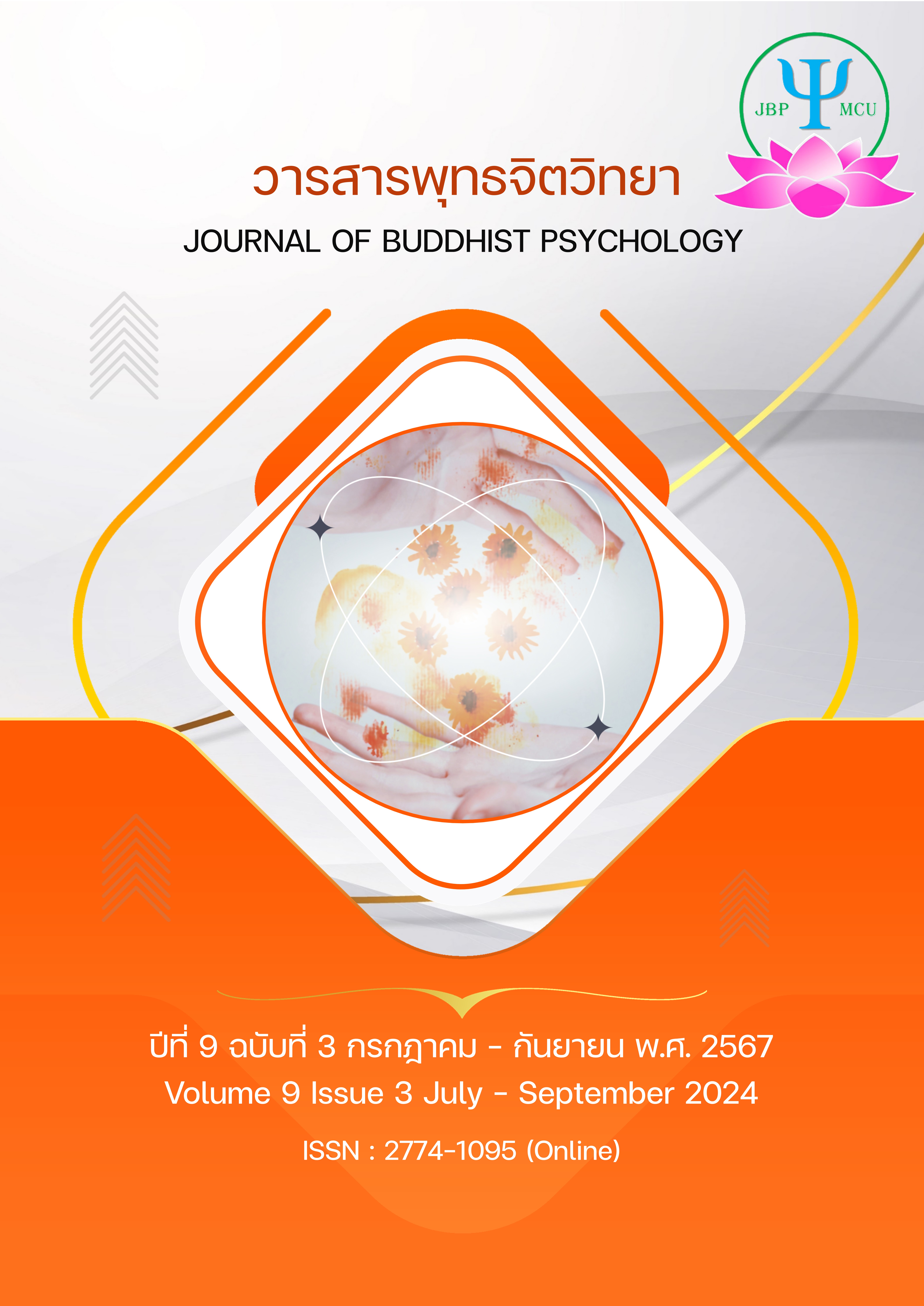ผลของโปรแกรมฝึกทักษะการกำกับอารมณ์ร่วมกับการส่งเสริมการรับรู้ความสามารถของตน ในการกำกับอารมณ์ต่อพฤติกรรมเสี่ยงฆ่าตัวตายในนักศึกษาพยาบาล
Main Article Content
บทคัดย่อ
การวิจัยนี้เป็นการวิจัยกึ่งทดลอง เพื่อศึกษาผลของโปรแกรมฝึกทักษะการกำกับอารมณ์ร่วมกับการส่งเสริมการรับรู้ความสามารถของตนในการกำกับอารมณ์ต่อพฤติกรรมเสี่ยงฆ่าตัวตายในนักศึกษาพยาบาล กลุ่มตัวอย่าง คือ นักศึกษาพยาบาล ของสถาบันการศึกษาแห่งหนึ่งในกรุงเทพมหานคร คัดเลือกจากเกณฑ์คัดเข้าจำนวน 40 คน แบ่งเป็นกลุ่มทดลองและกลุ่มควบคุม กลุ่มละ 20 คน กลุ่มทดลองได้รับโปรแกรมฝึกทักษะการกำกับอารมณ์ร่วมกับการส่งเสริมการรับรู้ความสามารถของตนในการกำกับอารมณ์ ประกอบด้วย 6 กิจกรรม ใช้เวลากิจกรรมละ 90 – 120 นาที เครื่องมือที่ใช้ในการวิจัย คือ 1) แบบวัดการรับรู้ความสามารถของตนในการกำกับอารมณ์ 2) แบบวัดพฤติกรรมเสี่ยงฆ่าตัวตาย และ 3) โปรแกรมฝึกทักษะการกำกับอารมณ์ร่วมกับการส่งเสริมการรับรู้ความสามารถของตนในการกำกับอารมณ์ วิเคราะห์ข้อมูลโดยใช้สถิติเชิงพรรณนาและวิเคราะห์ความแปรปรวนพหุคูณ ผลการวิจัยพบว่า
1) หลังการทดลองผลของค่าเฉลี่ยคะแนนการรับรู้ความสามารถของตนในการกำกับอารมณ์และค่าเฉลี่ยคะแนนพฤติกรรมเสี่ยงฆ่าตัวตายระหว่างกลุ่มทดลองและกลุ่มควบคุม มีความแปรปรวนที่แตกต่างกัน อย่างมีนัยสำคัญทางสถิติ (p<.05) โดยมีค่าขนาดอิทธิพล หรือ Partial Eta Squared เท่ากับ .351
2) หลังการทดลอง กลุ่มทดลองที่ได้รับโปรแกรมฝึกทักษะการกำกับอารมณ์ร่วมกับการส่งเสริมการรับรู้ความสามารถของตนในการกำกับอารมณ์ มีค่าเฉลี่ยคะแนนการรับรู้ความสามารถของตนในการกำกับอารมณ์สูงขึ้นกว่าก่อนทดลอง และค่าเฉลี่ยคะแนนพฤติกรรมเสี่ยงฆ่าตัวตายลดลงกว่าก่อนทดลอง อย่างมีนัยสำคัญทางสถิติ (p< .05)
สรุปได้ว่า โปรแกรมฝึกทักษะการกำกับอารมณ์ร่วมกับการส่งเสริมการรับรู้ความสามารถของตนในการกำกับอารมณ์มีประสิทธิภาพ สามารถส่งเสริมให้นักศึกษาพยาบาลมีการรับรู้ความสามารถของตนในการกำกับอารมณ์เพิ่มมากขึ้นและสามารถลดพฤติกรรมเสี่ยงฆ่าตัวตายของนักศึกษาพยาบาลได้
Article Details

This work is licensed under a Creative Commons Attribution-NonCommercial-NoDerivatives 4.0 International License.
References
กาญจนา คงมั่น และชุติมา ฮากิม. (2563). ปัจจัยที่ส่งผลต่อปัญหาสุขภาพจิตของนักศึกษาพยาบาล. วารสารพยาบาลทหารบก, 21(3), 331-339.
ขวัญใจ ฤทธิ์คำรพ. (2563). โปรแกรมการปรึกษาแบบบูรณาการที่มีต่อการกา กับอารมณ์ของนิสิตระดับปริญญาตรีที่มีภาวะซึมเศร้า (วิทยานิพนธ์ปรัชญาดุษฎีบัณฑิต). มหาวิทยาลัยศรีนครินทรวิโรฒ.
ณัฏฐลิณ คุ้มรอด และรังสิมันต์ สุนทรไชยา. (2560). ผลของโปรแกรมการกํากับอารมณ์ต่ออาการซึมเศร้าของผู้ป่วยโรคซึมเศร้า. วารสารการพยาบาลจิตเวชและสุขภาพจิต, 31(2), 136-151.
ธนพล บรรดาศักดิ์ และคณะ. (2564). การป้องกันภาวะซึมเศร้าในนักศึกษาพยาบาล. วารสารวิทยาลัยพยาบาลบรมราชชนนี อุตรดิตถ์, 13(1), 62-70.
พรพิมล พรมนัส. (2561). ผลของโปรแกรมการกำกับอารมณ์ต่อความสามารถทางอารมณ์และสังคมของเด็กที่มาจากครอบครัวหย่าร้าง (วิทยานิพนธ์มหาบัณฑิต). มหาวิทยาลัยธรรมศาสตร์.
วารีรัตน์ ถาน้อย, อทิตยา พรชัยเกตุ โอว ยอง, ภาศิษฏา อ่อนดี. (2555). ปัจจัยที่มีอิทธิพลต่อภาวะสุขภาพจิตของนักศึกษาคณะพยาบาลศาสตร์ มหาวิทยาลัยมหิดล. วารสารสภาการพยาบาล, 27(ฉบับพิเศษ), 60-76.
สืบตระกูล ตันตลานุกุล และปราโมทย์ วงศ์สวัสดิ์. (2560). ความเครียดและการจัดการความเครียดของนักศึกษาพยาบาล. วารสารวิทยาลัยพยาบาลบรมราชชนนี อุตรดิตถ์, 9(1), 81-92.
สุพัตรา สุขาวห และสุวรรณา อรุณพงค์ไพศาล. (2560). ปัจจัยเสี่ยงและทฤษฎีที่เกี่ยวข้องกับการฆ่าตัวตายในวัยรุ่น: การทบทวนวรรณกรรมเชิงลึก. วารสารสมาคมจิตแพทย์แห่งประเทศไทย, 62(4), 359-378.
สุรชัย เฉนียง และปาริชาติ เมืองขวา. (2562). พฤติกรรมเสี่ยงการฆ่าตัวตายในวัยรุ่น. วารสารพยาบาลศาสตร์
มหาวิทยาลัยสยาม, 20(39), 121-130.
Baer, M.M., et al. (2022). Associations of interpersonal and intrapersonal emotion regulation strategies to suicidal ideation and suicide attempts. Journal of Contextual Behavioral Science, 24, 1-9.
Bandura, A. (1997). Self-efficacy: The exercise of control. New York: W.H Freeman.
Caprara, G. V., & Gerbino, M. (2001). Affective perceived self-efficacy: The capacity to regulate
Caprara, G. V., et al. (2006). Looking for adolescents' well-being: Self-efficacy beliefs as determinants of positive thinking and happiness. Epidemiology and Psychiatric Sciences, 15(1), 30-43.
Chubdari, A., Rasuli, M., & Barzi, H. K. (2016). Effectiveness of emotion regulation training on reduction of symptoms in students with oppositional defiant disorder. International Journal of Emergency Mental Health and Human Resilience, 18(1), 1081-1085.
Fadoir, N. A., Lutz-Zois, C. J., & Goodnight, J. A. (2019). Psychopathy and suicide: The mediating effects of emotional and behavioral dysregulation.Personality and Individual Differences, 142, 1-6
Gratz, K.L., et al. (2015). Mechanisms of Change in an Emotion Regulation Group Therapy for Deliberate Self-harm Among Women with Borderline Personality Disorder. Behavior Research and Therapy, 65, 29-35.
Gross, J. J., & Jazaieri, H. (2014). Emotion, emotion regulation, and psychopathology: An affective science perspective. Clinical Psychological Science, 2(4), 387-401.
Gross, J. J., & John, O. P. (2003). Individual differences in two emotion regulation processes: implications for affect, relationships, and well-being. Journal of Personality and Social Psychology, 85(2), 348.
Hatkevich, C., Penner, F., & Sharp, C. (2019). Difficulties in emotion regulation and suicide ideation and attempt in adolescent inpatients. Psychiatry research, 271, 230-238.
Jiefeng, Y., Jianing, Y. and Jiaqi, G. (2020). The protective effects of youth assets on the associations among academic stress, regulatory emotional self-efficacy, and suicidal risk: A moderated mediation model. Children and Youth Services Review, 119, 105660.
Mesurado, B., Vidal, E. Mestre, A. (2018). Negative emotions and behaviour: The role of regulatory emotional self-efficacy. Journal of Adolescence, 64, 62-72.
Myers, S., & Hansen, B. B. (2007). The origin of vowel length neutralization in final position: Evidence from Finnish speakers. Natural language & linguistic theory, 25(1), 157-193.
negative affect and to express positive affect. In G. V. Caprara (Ed.), Self-efficacy assessment (pp. 35–50). Trento, Italy: Edizioni Erickson.
Plemmons, G., et al. (2018). Hospitalization for suicide ideation or attempt: 2008–2015. Pediatrics, 141(6), e20172426.
Röll, J., Koglin, U., & Petermann, F. (2012). Emotion Regulation and Childhood Aggression: Longitudinal Associations. Child Psychiatry and Human Development, 43(6), 909–923.
Shelef, L., Fruchter, E., Hassidim, A., & Zalsman, G. (2015). Emotional regulation of mental pain as moderator of suicidal ideation in military settings. European psychiatry,30(6), 765-769.
Thanoi, W., et al. (2010). Thai adolescent suicide risk behaviors: testing a model of negative life events, rumination, emotional distress, resilience and social support. Pacific Rim International Journal of Nursing Research, 14(3), 187-202.
Turner, A., & Hansen, C. (2006). Experimental Psychology (6th ed.). Belmont: C.A: Wadsworth.
Turpyn, C. C., et al. (2015). A Person-centered Approach to Adolescent Emotion Regulation: Associations with Psychopathology and Parenting. Journal of Experimental Child Psychology, 136, 1-16.
Turton, H., et al. (2021). The relationship between emotion dysregulation and suicide ideation and behaviour: A systematic review. Journal of affective disorders reports, 5, 100-136.
Zeng, B., et al. (2018). Depressive symptoms, post-traumatic stress symptoms and suicide risk among graduate students: The mediating influence of emotional regulatory self-efficacy. Psychiatry research, 264, 224-230.

